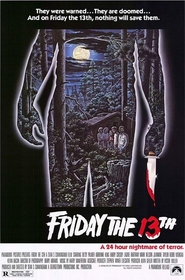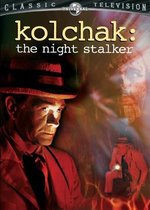Our editor-in-chief Nate Yapp is proud to have contributed to the new book Hidden Horror: A Celebration of 101 Underrated and Overlooked Fright Flicks, edited by Aaron Christensen. Another contributors include Anthony Timpone, B.J. Colangelo, Dave Alexander, Classic-Horror.com's own Robert C. Ring and John W. Bowen. Pick up a copy today from Amazon.com!
Friday the 13th (1980)
Sean S. Cunningham's Friday the 13th openly defies originality, borrowing liberally from John Carpenter's Halloween and Alfred Hitchcock's Psycho, but succeeds in spite of it. Although far from being the paradigm of the genre, the film nevertheless paves a succinct pathway through its boogeyman tale, striking a few familiar notes of its predecessors while creating its own unique beats along the way. It's a slasher flick stripped down to its most primal vices-sex and violence-and Friday the 13th unflinchingly bathes the audience in copious amounts of both.
There is an intended simplicity to Victor Miller's script, which unfolds like a good old-fashioned campfire scare-tale. As the film opens in 1958, the reputation of Camp Crystal Lake is forever tarnished as two camp counselors are brutally murdered after sneaking away to have sex. In the present day (on Friday, June 13th no less), a pack of plucky teens prepare to reopen the camp, now saddled with the nickname "Camp Blood," ignoring the warnings of the local townsfolk who believe the place to be cursed. Just as the camp is set to reopen, an anonymous killer begins picking off the teens one at a time, most notably those that have sex and those that go off looking for the ones killed while having sex. This leaves a select few survivors to come face-to-face with the curse of Camp Crystal Lake.
Friday the 13th draws most of its strength from its killer, who, in a wise choice from both Miller's script and Cunningham's direction, is scarcely seen. The film never suggests the killer's identity or intentionally misleads the audience with red herrings; what we as an audience know about the killer is just as little as the characters in the film. This tactic heightens the suspense, as the killer could literally be anyone. In fact, when the killer arrives at the end of the film, there are a few minutes when we're not even aware that we're staring at the perpetrator in the flesh. Even more deceiving is that the brief glimpses of the killer shown during early kills makes use of a stand-in who looks absolutely nothing like the true killer at the end. Although this hoodwinking is most likely due to a budget restraint, it inadvertently creates certain disarray in the audience that feeds into the tension of not knowing who the killer is.
Equally important to the film, if not nearly as successful, are the teenage protagonists. Essentially fodder for the film's villain, these kids provide an important vessel for which the audience to view the plot. None of the characters are particularly memorable (even the sole survivor), but to be fair the film never regards these characters too seriously. At one point in the film, a cop tells one of the teens, "Don't get smart with me," to which the teen replies, "Me? I'm as dumb as they come." It helps to mention that the teen is also shirtless and dressed like an Indian. Miller's script finds the right balance between ignorance and earnestness that these characters don't feel like parodies and more like truthful teenage archetypes.
In terms of gore, the effects of makeup guru Tom Savini are serviceable enough to enhance the scares, although those that have seen Dawn of the Dead will have seen better work from him. His effects in Friday the 13th do the trick-whether it's an axe to the face or a subtle slitting of the throat-and certainly the film's final scare is a direct result of one of Savini's masterpieces. Some of his other effects, regrettably, are marred with incredulous circumstances that are difficult to ignore. Take the arrow through the throat scene, for instance. How does someone beneath a bed feasibly push an arrow through the mattress and the throat of the person lying on top? Savini's effect for this particular scene is just as over-the-top as the idea of it, leaving the audience more disbelieved than perturbed.
Initially conceived to cash in on the success of Halloween, Friday the 13th does find its own footing as a solid slasher flick, but its opening moments show signs of its intent to be a coattail-rider for Carpenter's classic. Much of the thrill of the film's opening kill is lost when Cunningham decides to shoot it from a first-person perspective, slowly moving the camera in on the two counselors and butchering them from the killer's viewpoint. This scene directly harkens back to Halloween's similar and much more powerful opening scene just two-years prior when a prepubescent Michael Myers dons a clown mask and kills his sister in her bedroom. Although the intent is similar, the shock garnered the first time around is not nearly as prevalent the second time.
Not so coincidentally, Friday the 13th reaches even further back in the slasher timeline and rips a few notes out of Hitchcock's Psycho as well. In that film, Hitchcock gob smacked his audience when the film's heroine, Marion Crane, dies midway through the film in the infamous shower sequence. Similarly in Friday the 13th, the female character that becomes the focus after the Halloween-inspired intro winds up having her throat slashed in the woods no more than twenty-minutes later. Complimenting the scene, as well as the rest of the film thereafter, is a score from Harry Manfredini that is undeniably a take from Bernard Herrman's Psycho orchestral inlay. If it weren't for Manfredini's contribution of the haunting "ki ki ki ma ma ma" sound that foreshadows the killer, his score would be entirely throwaway.
Although it occasionally basks in the glow of its forerunners, Friday the 13th eventually emerges as one of the quintessential slasher films of the 1980s. Never overreaching in its intentions, the film panders to its audience on the most basic level-feeding a cast of promiscuous teens into a plot that ends in a hastening body count. It is the silver screen equivalent of a campfire tale meant to send all the other campers to their sleeping bags with nightmares.









Great write up. Nice to see
Great write up. Nice to see Jason get some respect. Or at least the movie that spawned the series that eventually led to Jason. It's funny that he wasn't in the first movie, nobody wore a hockey mask, and I don't think it had anything to do with the date in question. Most of things it came to be associated with only occur in later installments. I think that fact allows us to evaulate the film in a fresh light, kinda like what you did here.